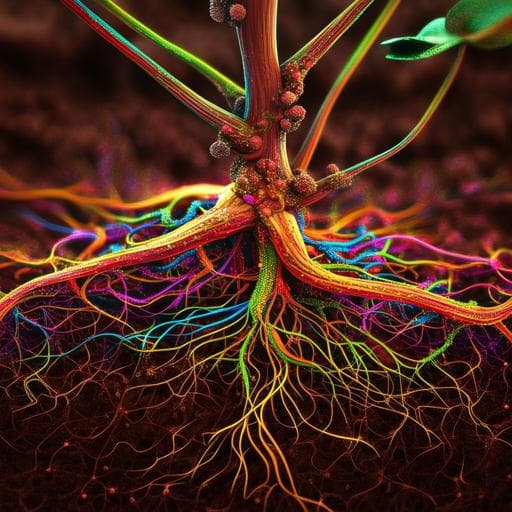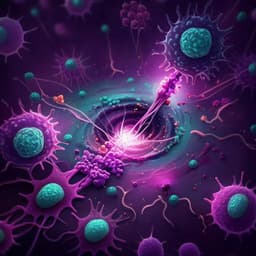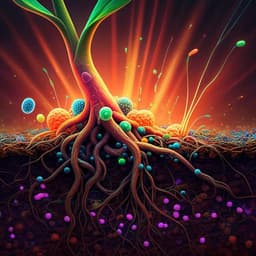
Agriculture
Growth, ionic homeostasis, and physiological responses of cotton under different salt and alkali stresses
H. Guo, Z. Huang, et al.
This study by Huijuan Guo, Zhijie Huang, Meiqi Li, and Zhenan Hou explores the impact of various salt-alkali stresses on cotton growth. Discover how these stresses affect ion absorption and physiological responses, revealing the plant's adaptability through antioxidant systems and ionic equilibrium adjustments.
~3 min • Beginner • English
Introduction
Soil salinization is a global problem that threatens sustainable agriculture. Cotton, though relatively salt-tolerant and used as a pioneer crop on salt-alkali soils, still suffers significant growth inhibition under salt-alkali stress. Neutral salts (NaCl, Na₂SO₄) primarily cause osmotic stress and ion toxicity, while alkaline salts (NaHCO₃, Na₂CO₃) impose high pH stress that disrupts ion balance. Crops exhibit distinct responses and tolerance mechanisms to these stress types, and the risk from alkali stress may be greater than from neutral salt stress. Maintaining intracellular ionic homeostasis is central to plant salt tolerance, but prior studies often examined only a subset of elements, leaving the ionome-wide responses and inter-element interactions under different salt-alkali stresses incompletely understood. Key salt-tolerance pathways include SOS1 and NHX1, which regulate Na⁺ efflux and vacuolar sequestration, respectively. This study aimed to clarify how different neutral and alkaline salt stresses affect cotton growth, physiological responses (membrane integrity, oxidative stress, osmotic adjustment), ionome composition in leaves, stems, and roots, element–Na relationships, and expression of Na⁺ transport-related genes involved in ionic homeostasis.
Literature Review
Previous work shows salt-alkali stress significantly inhibits cotton growth and root development, reducing biomass and causing ion toxicity due to disrupted ionic homeostasis. Ionomics provides a systems-level approach to characterize mineral nutrient and trace element profiles, essential for understanding element–element and element–environment interactions under stress. Salt stress commonly inhibits uptake of macroelements (N, P, K, Ca, Mg, S) and trace elements (Fe, Cu, Zn, Mn, B), leading to nutrient imbalances. Maintaining ionic homeostasis and osmotic equilibrium, along with reactive oxygen species (ROS) scavenging via antioxidant enzymes (SOD, POD, CAT), are critical defense mechanisms. The SOS pathway (SOS1) contributes to Na⁺ efflux at the plasma membrane, while NHX1 mediates vacuolar Na⁺ sequestration to maintain cytosolic ion balance. However, comprehensive ionome responses in cotton under contrasting neutral vs. alkaline salt stresses and the associated gene regulatory changes remain less explored.
Methodology
Greenhouse pot experiment conducted in 2019 at the College of Agriculture, Shihezi University experimental station (N 44°18′, E 86°02′), Xinjiang, China. Soil (0–30 cm, grey desert loam) baseline: salinity 0.35 dS m⁻¹, pH 7.86, total N 0.58 g kg⁻¹, organic matter 9.45 g kg⁻¹, available P 6.71 mg kg⁻¹, available K 142 mg kg⁻¹. Cotton cultivar: Lu-mian-yan No. 24. Treatments: Control (CK), NaCl (CS), Na₂SO₄ (SS), and Na₂CO₃ + NaHCO₃ (1:1; AS). Soil salinity/pH (1:2.5) per treatment (Table 1): CK EC 0.35 dS m⁻¹, pH 8.16; CS EC 1.39, pH 8.43; SS EC 2.01, pH 8.19; AS EC 0.63, pH 9.92. Soil preparation: air-dried, 2-mm sieved field soil equilibrated for 1 month with respective salt solutions to supersaturation (control with deionized water), then dried and sieved. Columns: 20 cm diameter × 60 cm height; soil packed in five 10-cm layers to 50 cm at bulk density 1.25 g cm⁻³ (20 kg per column). Drip irrigation: single emitter per column (0.4 m spacing), 2.1 L h⁻¹, pipe centered on column top. Sowing: April 28, 2019; 10 seeds per column; 3 L water post-sowing. Thinning at two true leaves to two uniform seedlings per column. Soil moisture maintained at 60–80% field capacity via drip irrigation. Experiment duration: 60 days after sowing. Sampling and measurements: Growth/biomass—three representative plants per treatment; leaves, stems, roots separated; fresh material fixed at 105 °C for 30 min, dried at 70 °C for 48 h, weighed, ground (1-mm). Root morphology—roots washed, stored cold; scanned (Epson Expression 1600); analyzed with WinRhizo V5.0 for length, surface area, volume. Physiological indices—functional leaves (third leaf on main stem) collected; REC by conductance; MDA (Wu et al., 2012); proline (Bates et al., 1973). Antioxidant enzymes—SOD (Zhang et al., 2012), POD (Tan et al., 2008), CAT (Cakmak & Marschner, 1992). Ionomics—100 mg tissue digested in 10 mL conc. HNO₃ (microwave digestion Milestone ETHOS A), acid driven off at 230 °C ~20 min, diluted to 25 mL; ICP-MS (Agilent 7700X) for Na, P, K, Ca, Mg, S, Fe, B, Mn, Zn, Cu, Mo, Ni, Si, Co, Al, Se in leaves, stems, roots. Gene expression—RT-qPCR for GhSOS1 and GhNHX1; primers listed (UBQ7 as housekeeping). qPCR: ABI 7300; reaction 10 µL with SYBR Premix; cycling 95 °C 5 min; 40 cycles 95 °C 15 s, 60 °C 1 min; relative expression by 2^-ΔΔCT. Statistics—SPSS 21.0; mean ± SE (n=3); Duncan’s test p<0.05 for treatment differences; Pearson correlations between Na and other elements (p<0.05). Ionome PCA performed in R (v4.0.3); hierarchical clustering via MetaboAnalyst online platform.
Key Findings
- Biomass: Total plant biomass decreased vs. CK by 57.55% (CS), 49.19% (SS), 58.61% (AS). Organ-specific decreases: CS—root 47.98%, stem 65.64%, leaf 32.07%; SS—root 46.86%, stem 51.17%, leaf 43.18%; AS—root 59.93%, stem 57.50%, leaf 31.17%.
- Root morphology: Relative to CK, root length/surface area/volume decreased by CS: 44.33%/25.62%/10.80%; SS: 40.53%/38.49%/38.40%; AS: 23.63%/20.85%/25.28%.
- Membrane damage and oxidative status: Leaf MDA increased by 211.72% (CS), 114.48% (SS), 208.28% (AS). REC increased by 74.06% (CS), 99.83% (SS), 31.54% (AS); REC higher under neutral salts than alkali stress.
- Antioxidant enzymes (leaves): SOD increased by 118.89% (CS), 159.92% (SS), 215.29% (AS); POD by 8.98% (CS), 16.80% (SS), 12.38% (AS); CAT by 139.78% (CS), 116.70% (SS), 275.91% (AS).
- Osmolyte: Proline increased by 230.07% (CS), 77.91% (SS), 264.19% (AS); magnitude AS > CS > SS.
- Ionome structure: PCA separated leaf, stem, and root ionomes by stress type. PC1 contributors—leaf: Na, Ca, Mn, Fe, Mo, Al, Co; stem: Na, P, Ca, Cu, Zn, Mo; root: Na, P, Mg, Mn, Mo, B. SS separated by PC2 in leaf (21.0% variance) and stem (25.0%); in roots, PC2 (32.7%) separated neutral (CS, SS) from alkaline (AS).
- Elemental concentration shifts vs. CK:
• Leaves: CS increased Na, Zn, Mn, Fe, B, Mo, Al, Co; decreased P, K, Ca, Mg, S, Cu. SS increased Na, S, Zn, Fe, Mo, Al, Co; decreased P, Ca, Mg, B, Cu, Se. AS increased Na, Fe, Mn, Zn, Cu, Mo, Ni, Co, Al, Si; decreased P, K, Ca, Mg, S, B, Se.
• Stems: CS increased Na, Zn, Mn, Fe, Mo, Al; decreased B, Ca, Cu, P, K, Mg, S. SS increased Na, S, Zn, Fe, Mo, Al, Mn, Co; decreased P, Ca, Mg, Cu. AS increased Na, Mn, Zn, Mo, Ni, Co, B; decreased Al, Ca, Cu, Fe, Mg, P, S.
• Roots: CS increased Na, P, Mg, Cu, Zn, Mn, Co, Mo, Al; decreased Ca. SS increased Na, Mg, S, Zn, Fe, Mo, B, Cu, Al, Mn, Ni, Co; decreased P, Ca. AS increased Na, Mg, Mn, Mo, Ni, Co, B; decreased Al, Fe, P, S.
- K/Na ratio: Decreased significantly in all organs. Leaves: −87.46% (CS), −92.58% (SS), −95.20% (AS). Stems: −84.16% (CS), −92.22% (SS), −94.44% (AS). Roots: −76.92% (CS), −84.43% (SS), −84.80% (AS).
- Correlations with Na: Numerous significant negative correlations with macronutrients (e.g., Ca, Mg, K, P, S) and positive correlations with several micronutrients/beneficial elements (e.g., Zn, Mo, Mn, Al, Fe, Co) depending on tissue and stress type; under SS in roots, Na positively correlated with almost all elements except Ca, P, Se.
- Gene expression: In leaves, GhSOS1 expression increased significantly under salt (NaCl, Na₂SO₄) but decreased under alkali (Na₂CO₃ + NaHCO₃). In roots, GhSOS1 decreased under all stresses. GhNHX1 increased significantly in leaves and roots under salt stress; differences under alkali stress were not significant.
- Comparative stress effects: Na and Mo concentrations increased across organs under all stresses. Under NaCl, Ca uptake inhibited; transport capacity of P, Mg, Cu reduced; balance maintained by increased uptake/transport of Zn, Mn, Al, Mo. Under Na₂SO₄, P and Ca uptake inhibited; transport capacity of Mg, B, Cu reduced; balance maintained by promoting S, Zn, Fe, Mo, Al, Co. Under Na₂CO₃ + NaHCO₃, P and S uptake inhibited; transport capacity of Mg, B reduced; Al and Fe transport increased; balance maintained by promoting Mn, Mo, Ni, Co.
Discussion
The study demonstrates that neutral and alkaline salt stresses impose distinct constraints on cotton physiology and mineral nutrition. Growth inhibition across treatments aligns with osmotic and ionic toxicity under neutral salts and high pH-induced nutrient disruption under alkaline salts. Increased REC under neutral salts indicates greater impairment of membrane permeability, whereas higher MDA under alkali suggests stronger oxidative damage, despite robust upregulation of antioxidant enzymes (SOD, POD, CAT) under all stresses. Elevated proline, especially under alkali stress, supports its role in osmotic adjustment and potential pH buffering. Ionome analyses reveal that cotton re-establishes ionic homeostasis through element-specific uptake and transport adjustments that differ by stress type: neutral salts primarily disturb ion balance with selective uptake reductions (e.g., Ca, P, Mg, Cu), whereas alkali stress both disrupts ion balance and broadly suppresses mineral element absorption due to high pH chemistry (notably reducing P and S availability and transport). The pronounced decline in K/Na ratios across organs underscores competitive Na⁺ interference with K⁺ nutrition, a key determinant of salt tolerance. Upregulation of GhSOS1 and GhNHX1 under neutral salts, but suppression or lack of induction under alkali stress, indicates that high pH may impair Na⁺ efflux and vacuolar sequestration pathways, contributing to Na accumulation and exacerbated ionic disequilibrium. Collectively, the results explain how cotton differentially modulates antioxidant defenses, osmolyte levels, and ion transport to cope with neutral versus alkaline salt environments, addressing the central question of stress-type-specific ionic homeostasis strategies.
Conclusion
Salt-alkali stress in cotton reduced biomass and root system traits and lowered K/Na ratios, while increasing membrane damage markers (REC, MDA), antioxidant enzyme activities, and proline. Ionomic profiling showed broad, stress-type-specific reconfiguration of mineral uptake and transport: under NaCl, inhibited Ca uptake and reduced P, Mg, Cu transport were countered by increased Zn, Mn, Al, Mo; under Na₂SO₄, inhibited P and Ca uptake and reduced Mg, B, Cu transport were offset by increased S, Zn, Fe, Mo, Al, Co; under Na₂CO₃ + NaHCO₃, inhibited P and S uptake and reduced Mg, B transport coincided with increased Al, Fe transport and enhanced Mn, Mo, Ni, Co. Na and Mo concentrations increased across organs under all stresses. Gene expression patterns (GhSOS1, GhNHX1) rose under neutral salts but declined or showed no significant change under alkali stress, partially explaining Na accumulation patterns. The study provides a theoretical basis for improving cotton tolerance via ionic regulation and rational fertilization in salt-alkali soils and informs breeding for salt-alkali tolerant cultivars.
Limitations
Related Publications
Explore these studies to deepen your understanding of the subject.







